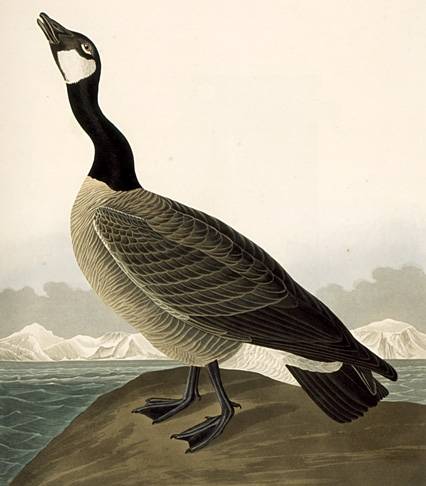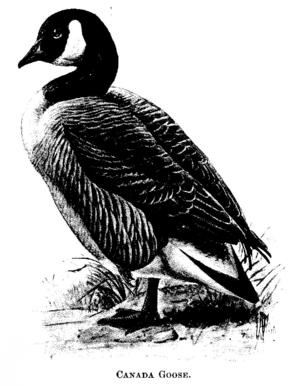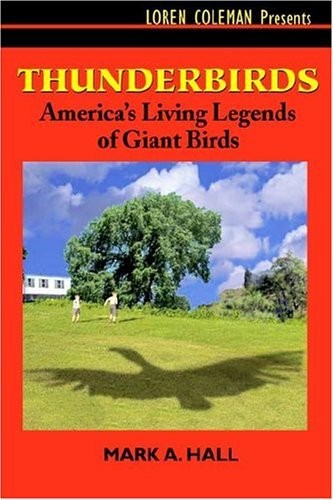Flock of Geese or Giant Bird?
Posted by: Loren Coleman on January 15th, 2009

The breaking news out of New York City is that an Airbus has been brought down by Canada geese. But what if it was something else? Of course, it wasn’t, but we have to look at all the angles. (Updated with recent bird collision data, at the end.)
A flock of Canada geese (Branta canadensis) – please note, not “Canadian” geese as some news people are saying – has apparently hit or were hit by an Airways jet, an Airbus A320. The plane then had to be ditched in the Hudson River, New York City, and sunk below the waterline.
The flight was US Airways flight 1549, which took off at 3:26 p.m. on January 15, 2009, from LaGuardia, headed for Charlotte, N.C.
Reportedly 155 people are on board. New York City firefighters, federal transportation officials and an armada of boats were responding to the accident. It was not immediately clear if there were injuries, but recent news bulletins state everyone on board is safe.

Collisions with Giant Birds have been a background topic of interest to cryptozoologists involved in Thunderbird research.
The files contain some intriguing cases, for example:
(1) 1947, a pilot reports a near-collision over Arizona, bird said to have a wingspan of over 30 feet (9 meters);
(2) May 1961, a New York businessman reports his Piper Cub plane was followed by a bird that was so large he thought it was another small airplane, over the Hudson Valley, Hudson River, New York, and
(3) November 1962, a Maryland airplane crash was blamed on a collision with a giant bird, as reported by author Jack Pearl in 1963.
Mark A. Hall writes of the above in his Thunderbirds book.
On a mundane level, however, each year, planes collide birds in mid-air causing hundreds of millions of dollars in damage. This event is, no doubt, the case with this story, if the eyewitness accounts confirm the initial sightings of the geese.
For the cryptozoological point of view of the developing news, see Mark A. Hall’s Thunderbirds: America’s Living Legends of Giant Birds, and Jerome Clark’s and my Creatures of the Other Edge, concerning the history of cryptid large birds.

^^^^^
CNN has published an article, “Biologist: Birds competing for airspace with planes” with factoids of some interest. Here are parts of this selection.
The problem of planes hitting birds comes down to a key fact: “We’re competing for airspace,” says Richard Dolbeer, a biologist who spent 20 years studying the problem at the U.S. Department of Agriculture.
Populations of large birds have increased dramatically since the 1970s, when environmental regulations were instituted in the United States. Birds have become more accustomed to living in urban environments near airports and the number of airline flights has risen sharply, according to Dolbeer.
Dolbeer, who retired in September 2008 and is now a consultant on the issue, spoke with CNN hours after a US Airways plane crash-landed in the Hudson River in New York after an apparent bird strike. He retired as National Coordinator for the Airport Wildlife Hazards Program and was chairperson of Bird Strike Committee-USA from 1997-2008.
CNN: How big a problem are bird strikes?
Dolbeer: Every year, approximately 7,000 to 8,000 bird strikes are reported to the Federal Aviation Administration primarily by commercial airlines nationwide. The reporting is a voluntary system. It’s not mandatory, so we know that not all of the bird strikes are being reported. We estimate that as much as 80 percent of the strikes are not reported.
It’s a fairly common occurrence to have bird strikes, but to have bird strikes that would disable both engines on an aircraft is fortunately a rare event.
CNN: What are some of the most serious instances of bird strikes?
Dolbeer: In 1995, at Elmendorf Air Force Base in Alaska, a Boeing 707, a wide-bodied jet adapted to military use as a surveillance plane, ingested Canada geese into two of four engines. It crashed a mile away and killed 24 airmen.
In Rome, Italy, in November, a Boeing 737, which is very similar to the Airbus 320, flew through a flock of starlings and both engines were disabled. The pilot was able to land the plane on the runway, but it collapsed the landing gear and did extensive damage to the aircraft. There were a few injuries, but no one was killed.
Last March in Oklahoma City, a business jet was taking off and it struck a flock of white pelicans, which is another species which is increasing. It crashed into a wood lot and killed all five businesspeople aboard.
The root of the problem right now is that because of the very successful wildlife conservation programs in North America since the 1970s, we’ve seen a tremendous resurgence of many wildlife species, particularly large bird species — species that weigh over 4 pounds, including Canada geese, snow geese, bald eagles, great blue herons, double-crested cormorants, turkey vultures and black vultures.
In fact, of the 36 species of birds in North America that weigh over 4 pounds, 24 of those have shown population increases, nine have shown stable populations and only one has shown a decline in the last 30 years. The Canada goose population in the United States — the resident Canada geese, not the migrant birds from Canada — has increased from 1 million birds in 1990 to about 3.9 million in 2008.
In addition to these populations increasing, they’ve also adapted to urban environments. They’re not afraid to associate with people. Traffic doesn’t bother them, aircraft don’t bother them. So they’re more likely to be seen near airports.
Another important factor is modern turbofan aircraft like the Airbus 320. Their engines are much quieter than older aircraft. And almost all the noise comes out of the back of the engine. Birds are less able to hear or see modern aircraft. There are more airplanes in the sky, more birds in the sky and this is where the conflict comes in.
The number of strikes being reported is definitely increasing. In 1990, the FAA had approximately 1,750 strikes reported. And in 2007, the last year we have data, we had 7,600.
Some of that may be due to a little better reporting, but there are also more aircraft flying today.
…snip…
About bird strikes
(CNN) — Information on bird strikes by aircraft, according to the Web
site of Bird Strike Committee.• Since 1975, five large jetliners have had major accidents in which bird strikes played a role.
• The most deadly civil crash was at Boston Logan Airport in 1960, when 62 people were killed after a strike. In that crash, a flock of starlings was ingested by all four plane engines. The plane fell into Boston Harbor.
• More than 82,000 bird strikes were reported to the Federal Aviation Administration from 1990-2007.
• The committee estimates that number is 20 percent of the strikes that actually happened.
• Most bird strikes happen during takeoff and landing.
• The frequency of the strikes has increased since the 1970s because of conservation efforts and quieter aircraft.
• A bird striking a single engine is generally not enough to cause a jetliner to crash. Because birds tend to travel in flocks, however, there is the potential for strikes of multiple engines.
• The FAA estimates bird strikes cost U.S. airlines more than $500 million annually.
• Commercial aircraft are certified to be able to withstand engine strikes by single birds up to four pounds.
• Thirty-six bird species in North America weigh more than four pounds — many traveling in flocks.
• In large numbers, smaller birds, including starlings, gulls and mourning doves, have caused crashes.
• The Wright brothers recorded the first known bird strike two years
after their maiden flight. “Chased flock of birds for two rounds and killed one,” Orville Wright wrote.
About Loren Coleman
Loren Coleman is one of the world’s leading cryptozoologists, some say “the” leading living cryptozoologist. Certainly, he is acknowledged as the current living American researcher and writer who has most popularized cryptozoology in the late 20th and early 21st centuries.
Starting his fieldwork and investigations in 1960, after traveling and trekking extensively in pursuit of cryptozoological mysteries, Coleman began writing to share his experiences in 1969. An honorary member of Ivan T. Sanderson’s Society for the Investigation of the Unexplained in the 1970s, Coleman has been bestowed with similar honorary memberships of the North Idaho College Cryptozoology Club in 1983, and in subsequent years, that of the British Columbia Scientific Cryptozoology Club, CryptoSafari International, and other international organizations. He was also a Life Member and Benefactor of the International Society of Cryptozoology (now-defunct).
Loren Coleman’s daily blog, as a member of the Cryptomundo Team, served as an ongoing avenue of communication for the ever-growing body of cryptozoo news from 2005 through 2013. He returned as an infrequent contributor beginning Halloween week of 2015.
Coleman is the founder in 2003, and current director of the International Cryptozoology Museum in Portland, Maine.










Correct me if I am wrong, but wasn’t there a Mothman sighting mention in Mothman Prophecy when Mothman chased a plane?
At this point I see nothing in this particular case to lead me to believe that this plane was brought down by anything other than a flock of birds. This is an occurrence that happens from time to time, and unless there is evidence to the contrary, that seems like a solid explanation. To mere, there isn’t any reason to jump to an unknown here.
The reports of collisions with giant birds are very interesting, but I wonder if in some cases, the sighting of these could have been caused by flocks of birds as well. It seems to me that under certain circumstances, a tightly packed flock of birds could appear to be a single, larger animal. Granted, pilots are possibly used to seeing bird flocks, but I’m not sure the possibility can be entirely ruled out.
As with those two above mentioned sightings, in those cases the pilots reported seeing a single bird, so I am inclined to go along with Mystery-man here…
I see the point Loren is trying to make here, with possibilities, but again, if there is no “weirdness” mentioned, it’s better not to start trying to look for it…but in such cases look at all the info to see if there are any indications of possible cryptid intervention.
Concerning giant birds, however, I could see how something that size would probably take an interest in a single engine plane, and possibly follow it or interfere with it out of curiosity…or even possibly seeing it as a threat to its space/territory…
I understand that both engines were damage and quit to cause the emergency land in the river. I don’t see how a “giant bird” could damage both engines and not be seen on the airport radar beforehand. If a “giant bird” was that big & in the area of the airport it WOULD show up on the radar designed to see plane of that size. I think this is just disparate news to make a blog on a slow day. BIRDS STRIKE PLANE EVERY DAY. Are they all “giant birds” or just the ones that make the evening news?
I was not saying this was a weird encounter, I was commenting on Loren’s comments about large wing spanned birds being sighted by pilots.
Some other thoughts that I’ve been having concerning actual collisions with giant birds (rather than sightings) is the matter of the kind of damage the bird itself would sustain, and what this would mean in terms of sightings, physical evidence, and such.
I doubt a collision of this force would leave the bird entirely unharmed. When a car hits a deer, for instance, whether it runs off or not, there are likely going to be injuries on the deer in addition to the damage to the car. There would almost certainly be physical evidence left behind from such a collision, such as hair or blood. I find it hard to believe that a giant bird would be able to collide with a plane with enough force to make it crash while incurring no injuries of its own, and without leaving a single physical trace behind. If a plane were to be brought down by a giant bird, I would expect that the bird is probably not going to be feeling so hot either. I think this has great importance for the examination of evidence.
Due to its injuries, it could become grounded, or it might not be able to feed itself and in turn search for easy food sources, both of which could possibly expose it to more sightings by hikers and whatnot, or provide a possible approach for cryptozoologists to search for the animal. The creature might fly erratically, which might bring more attention to it, or bring it closer to airspace where more people might see it. The creature might even die from its injuries, which could maybe turn up a corpse if it was found before decomposition and the ravages of scavengers could take full effect. Since the location of the collision would be known, the general area of where to look for a possible body could perhaps be more quickly deduced.
At the very least, some physical evidence could be left behind. Blood, feathers, even careful examination of the points of impact upon the plane caused by a large animal, the these sorts of things would go a long way towards trying to identify a giant mystery bird.
These are just a few things that I think need to be considered when weighing these giant bird collision reports.
The only time a big bird knocked down an airplane and flew away came, I believe in the “old German Ace” episode of the original Jonny Quest series. How’s that for an oscure pop-culture reference?
A large bird took down a four-engined, zillion-dollar USAF B-1B bomber in 1987 when the plane struck a white pelican. The dark humor passed around those of us in the Air Force at the time was that “B-1B” stood for “Birds 1, Bombers nothing.”
I’ve heard of birds flying in ‘V’ formations before, but not in the shape of a big bird. And if it was multiple smaller birds then why did the pilot claim to see a single, huge bird?
I found this online. It was a picture taken of US Airways flight 1549 after being pulled from the Hudson river on January 17, 2009. Is this another “Mothman” sighting?
http://news.yahoo.com/nphotos/Hudson-River-Manhattan-New-York/photo//090118/480/1d321d97a6ed454782cafc8b1ea2aef7//s:/ap/plane_splashdown_scenarios
Robotnik, if you thought I was referring to you, I was not. I was not clear I guess, but what I meant was that there did not seem anything out of the ordinary (other than a flock of birds bringing down a jet) present to suggest something crypto—details that might have eluded to the fact that there might have been another explanation than a flock of birds.
Since both engines were damaged, and birds were involved, there were almost certainly more than one bird present and involved.
And to MattBille…good reference 🙂 Johnny is the bestest crypto-cartoon I’ve ever seen:)